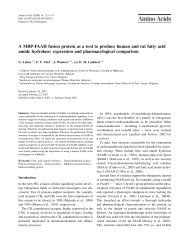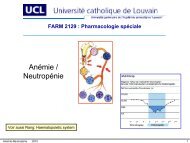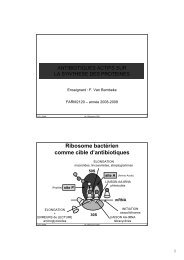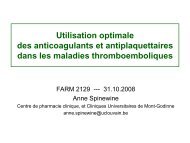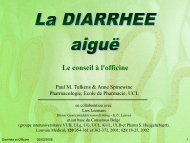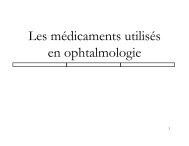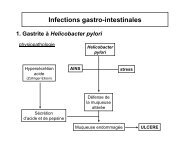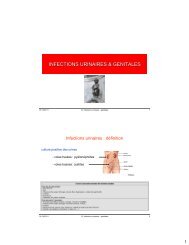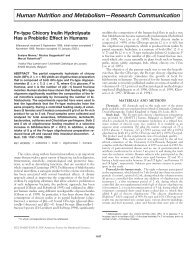Role of apoptosis for mouse liver growth regulation and tumor ...
Role of apoptosis for mouse liver growth regulation and tumor ...
Role of apoptosis for mouse liver growth regulation and tumor ...
Create successful ePaper yourself
Turn your PDF publications into a flip-book with our unique Google optimized e-Paper software.
1993). In NDEA → PB-treated mice, eosinophilic<br />
<strong>and</strong> clear cell foci were found to constitute the vast<br />
majority <strong>of</strong> the preneoplastic cell population, similarly<br />
to previous observations (Lee, 1997, 2000; Wastl<br />
et al., 1998; Christensen et al., 1999; Goldsworthy<br />
<strong>and</strong> Fransson-Steen, 2002). In the present overview,<br />
the differences in the <strong>growth</strong> parameters <strong>of</strong> C3H/He<br />
<strong>and</strong> C57Bl/6J mice are described in principle <strong>for</strong> one<br />
interim time point <strong>of</strong> our long-term study, namely at<br />
52 weeks <strong>of</strong> the experiment (Table 4). At this stage,<br />
in the <strong>liver</strong> <strong>of</strong> C57Bl/6J mice a few PPF (sum <strong>of</strong><br />
all phenotypes, namely eosinophilic, clear cell, amphophilic,<br />
tigroid, basophilic, vacuolated cell foci)<br />
were detectable only in animals subjected to the initiating<br />
treatment with NDEA (Table 5). In contrast, in<br />
C3H/He mice PPF appeared more frequent <strong>and</strong> were<br />
found even in control animals (“0–0”; Table 5). This<br />
snapshot at 52 weeks <strong>of</strong> the experiment reflects a coherently<br />
different <strong>growth</strong> kinetics <strong>of</strong> PPF in C3H/He<br />
<strong>and</strong> C57Bl/6J mice over time with respect to foci<br />
number <strong>and</strong> size (not shown) <strong>and</strong> the development <strong>of</strong><br />
HCA <strong>and</strong> HCC.<br />
PPF, HCA <strong>and</strong> HCC were surveyed <strong>for</strong> cell birth (labeling<br />
index = LI) <strong>and</strong> cell death (<strong>apoptosis</strong>-index =<br />
AI), the results are summarized in Table 5 (note:<br />
<strong>for</strong> PPF, only data <strong>of</strong> eosinophilic <strong>and</strong> clear cell foci<br />
(=PPF(EC)) are shown)—(1) in both strains, the cell<br />
birth rate was lowest in phenotypically normal <strong>liver</strong><br />
(NL) <strong>and</strong> in general, gradually increased from NL to<br />
PPF(EC) to HCAs <strong>and</strong> finally, to HCCs, very much<br />
like our previous observations on hepatocarcinogenesis<br />
in rat <strong>and</strong> human <strong>liver</strong> (Grasl-Kraupp et al., 1997);<br />
(2) notably, C3H/He mice treated with PB exhibited<br />
a significantly higher rate <strong>of</strong> DNA synthesis in PPF,<br />
HCA <strong>and</strong> HCC cells as compared to the corresponding<br />
C57Bl/6J mice (2.2%–6.9% versus 0.23%–2.3%);<br />
(3) in NL <strong>of</strong> both <strong>mouse</strong> strains, apoptoses were undetectable<br />
or very few (C3H/He 0%–0.04%; C57Bl/6J<br />
0%–0.03%); (4) PPF(EC), HCA <strong>and</strong> HCC exhibited a<br />
slightly increased apoptotic activity; the highest apoptotic<br />
activity tended to occur in HCC <strong>of</strong> C3H/He mice;<br />
(5) PB-treatment did not result in a consistent manifestation<br />
<strong>of</strong> an anti-apoptotic effect; (6) overall, histological<br />
analysis did not refer to a significant difference<br />
<strong>of</strong> apoptotic activity in the <strong>liver</strong>s <strong>of</strong> C3H/He <strong>and</strong><br />
C57Bl/6J mice. However, apoptotic activity in phenotypically<br />
normal as well as in (pre)neoplastic <strong>liver</strong><br />
tissue was much lower as compared to previous obser-<br />
W. Bursch et al. / Toxicology Letters 149 (2004) 25–35 31<br />
vations on rat <strong>liver</strong> carcinogenesis (Schulte-Hermann<br />
et al., 1990; Grasl-Kraupp et al., 1997).<br />
In a further approach to elucidate the role <strong>of</strong> cell<br />
proliferation versus <strong>apoptosis</strong> <strong>for</strong> <strong>growth</strong> <strong>of</strong> PPF<br />
we calculated the daily <strong>growth</strong> rates <strong>of</strong> the PPFs<br />
<strong>and</strong> HCAs from histologically determined labeling<br />
indices <strong>of</strong> the individual lesions. These values<br />
were compared with the daily <strong>growth</strong> rate estimated<br />
from the increase in cell number <strong>of</strong> lesions as described<br />
by Schulte-Hermann et al. (1990). Briefly,<br />
the <strong>growth</strong> rate was calculated using the following<br />
<strong>for</strong>mula—N = No • e k• t , with N0 = number <strong>of</strong> cells<br />
per lesion at start (i.e. at initiation with NDEA, N0<br />
was set 1; t = 0), k = daily proliferation rate, <strong>and</strong><br />
N = number <strong>of</strong> cells per lesion after experimental<br />
period t (in days). N was obtained from the average<br />
size <strong>of</strong> PPFs, or HCAs, respectively, (not shown); the<br />
number <strong>of</strong> cells per cross section was trans<strong>for</strong>med<br />
into number <strong>of</strong> cells per volume, assuming spherical<br />
shapes. As an estimate <strong>of</strong> k it was assumed that the<br />
LI obtained reflected the number <strong>of</strong> cells replicating<br />
per day. Furthermore, an exponential <strong>growth</strong> <strong>of</strong> hepatocellular<br />
lesions was assumed. As shown in Table 6,<br />
the experimentally found <strong>and</strong> calculated daily <strong>growth</strong><br />
rates were almost identical; it should be emphasized<br />
that this calculation does not account <strong>for</strong> <strong>apoptosis</strong>.<br />
Thus, these findings suggest that foci <strong>growth</strong> occurs<br />
without significant elimination <strong>of</strong> initiated cells. The<br />
molecular basis <strong>for</strong> the low rate <strong>of</strong> <strong>apoptosis</strong> in cancer<br />
prestages <strong>of</strong> <strong>mouse</strong> <strong>liver</strong> as observed by us <strong>and</strong> others<br />
is not yet clear. Interestingly, typical lesions resulting<br />
from the NDEA → PB-protocol, namely eosinophilic<br />
PPF <strong>and</strong> <strong>tumor</strong>s, do not overexpress bcl-2 (Lee,<br />
1997). Based upon results on chronic PB-treatment <strong>of</strong><br />
B6C3F1 mice without initiation by a genotoxic agent<br />
Christensen et al. (1999) reported expression <strong>of</strong> BclXL<br />
in the majority <strong>of</strong> acidophilic foci <strong>and</strong> adenomas,<br />
but only a small fraction <strong>of</strong> these lesions to express<br />
bcl-2.<br />
Consequently to the lack <strong>of</strong> apoptoses, the <strong>growth</strong><br />
<strong>of</strong> PPF in <strong>mouse</strong> <strong>liver</strong> predominantly is affected<br />
by the rate <strong>of</strong> cell proliferation; cancer susceptible<br />
C3H/He mice exhibit a higher proliferative activitiy<br />
than C57Bl/6J-mice. Furthermore, the progression<br />
<strong>of</strong> cancer prestages to HCC may be associated with<br />
an increased sensitivity to pro-apoptotic signals, as<br />
indicated by the present data as well as by a previous<br />
independent analysis <strong>of</strong> HCCs <strong>of</strong> C3H/He mice



